

Interactive Mobile Projectors. Mobile projectors are small projectors that can be embedded in handheld computing devices such as smartphones and tablets.
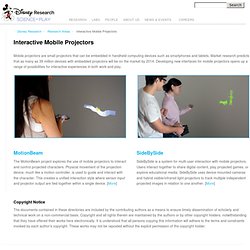
Market research predicts that as many as 39 million devices with embedded projectors will be on the market by 2014. Developing new interfaces for mobile projectors opens up a range of possibilities for interactive experiences in both work and play. MotionBeam The MotionBeam project explores the use of mobile projectors to interact and control projected characters. CHI 2012: It's the experience! INTERACT 2013. MobileHCI 2011: the 13th International Conference on Human-Computer Interaction with Mobile Devices and Services. Pranav Mistry: The thrilling potential of SixthSense technology. * Digital things. WebHome < LSPgroup < Foswiki. Projects.csail.mit.edu/wiki/pub/LSPgroup/WebHome/phonefusion.pdf. Increasing fuel efficiency with a smartphone. In July, at the Association for Computing Machinery’s MobiSys conference, researchers from MIT and Princeton University took the best-paper award for a system that uses a network of smartphones mounted on car dashboards to collect information about traffic signals and tell drivers when slowing down could help them avoid waiting at lights.

By reducing the need to idle and accelerate from a standstill, the system saves gas: In tests conducted in Cambridge, Mass., it helped drivers cut fuel consumption by 20 percent. Cars are responsible for 28 percent of the energy consumption and 32 percent of the carbon dioxide emissions in the United States, says Emmanouil Koukoumidis, a visiting researcher at MIT who led the project. “If you can save even a small percentage of that, then you can have a large effect on the energy that the U.S. consumes,” Koukoumidis says. Fixed or flexible? Theory into practice. Layer 8: DARPA wants smartphone app developers for super sensor program. Scientists at the Defense Advanced Research Projects Agency are looking for a few good smartphone application developers to make programs that will make sensor systems in everything from unmanned aircraft to cameras more sophisticated and intelligent.
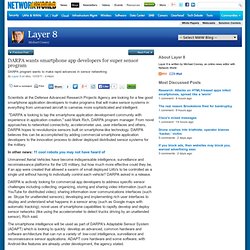
"DARPA is looking to tap the smartphone application development community with experience in application creation," said Mark Rich, DARPA program manager. From novel approaches to networked connectivity, accelerometer use, user interfaces and others, DARPA hopes to revolutionize sensors built on smartphone-like technology. DARPA believes this can be accomplished by adding commercial smartphone application developers to the innovation process to deliver deployed distributed sensor systems for the military. MobileHCI 2011: the 13th International Conference on Human-Computer Interaction with Mobile Devices and Services.
Publications. In Press Article Multimedia Systems This paper presents a RESTful Web service platform for building mixed reality applications for both Web browsers and mobile clients.

Having a common service backend makes creating applications fast, simple, and open to 3rd parties. The paper presents two mixed reality applications that have been built on the platform. Pervasive Computing. * At Google X, a Top-Secret Lab Dreaming Up the Future. It’s a place where your refrigerator could be connected to the Internet, so it could order groceries when they ran low.
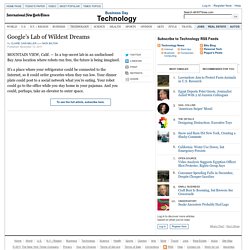
Your dinner plate could post to a social network what you’re eating. Your robot could go to the office while you stay home in your pajamas. And you could, perhaps, take an elevator to outer space. These are just a few of the dreams being chased at X, the clandestine lab where Google is tackling a list of 100 shoot-for-the-stars ideas. MIT Interface and gesture. * Microsoft Research: Computational User Experiences. Interactively Stylizing Camera Motion Neel Joshi, Dan Morris, Michael Cohen Proceedings of ACM CHI 2014, to appear.
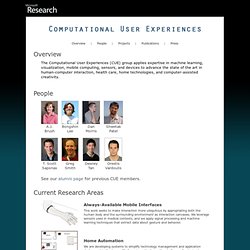
Next Media Research. Microsoft Next Media Research group focuses on developing innovative consumer media experiences that are possible with the growth in computing power, connectivity and storage in a compelling, elegant and transparent way in the 3 to 10 year timeframe with the goal of inspiring future hardware, software, services and features.
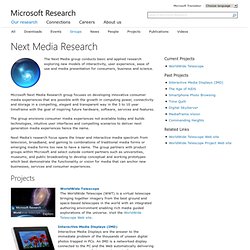
The group envisions consumer media experiences not available today and builds technologies, intuitive user interfaces and compelling scenarios to deliver next generation media experiences hence the name. Interactive Visual Media. The Interactive Visual Media Group develops state-of-the-art algorithms for digital photography and video.
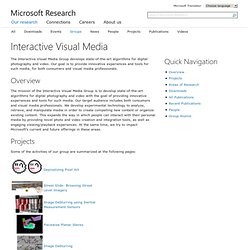
Our goal is to provide innovative experiences and tools for such media, for both consumers and visual media professionals. The mission of the Interactive Visual Media Group is to develop state-of-the-art algorithms for digital photography and video with the goal of providing innovative experiences and tools for such media. Our target audience includes both consumers and visual media professionals. Lost in Translation: Understanding the Possession of Digital Things in the Cloud. Lost in Translation: Understanding the Possession of Digital Things in the Cloud William Odom, Abigail Sellen, Richard Harper, and Eno Thereska5 May 2012 People are amassing larger and more diverse collections of digital things.
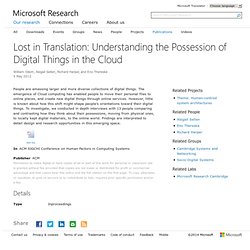
The emergence of Cloud computing has enabled people to move their personal files to online places, and create new digital things through online services. * Camera Culture. Vitor Pamplona, Manuel Oliveira, Erick Passos, Ankit Mohan, David Schafran, Jason Boggess and Ramesh Raskar.

Tangible Media. Hiroshi Ishii, Sean Follmer, Daniel Leithinger, Samuel Luescher, Alex Olwal, Akimitsu Hogge and Jinha Lee Recent research in 3D user interfaces has pushed in two directions: immersive graphics and actuated tangible shape displays. Fluid Interfaces.